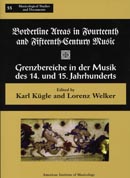Borderline Areas in Fourteenth and Fifteenth-Century Music
Grenzbereiche in der Musik des 14. und 15. Jahrhunderts
| Autoren/Herausgeber: |
Lorenz Welker |
|---|---|
| Erschienen: | 2009 |
Borderline Areas in Fourteenth and Fifteenth-Century Music. Grenzbereiche in der Musik des 14. und 15. Jahrhunderts. Edited by Karl Kügle and Lorenz Welker. Münster and Middleton 2009 (= Musicological Studies and Documents, Vol. 55, American Institute of Musicology).
This volume unites eleven essays in four languages, selected among papers first presented at the International Symposia in Late Medieval and Renaissance Music held at Kloster Neustift/ Novacella, South Tyrol, in 1997 and 2000. Their common thread is the exploration of borders and borderline areas in music of the fourteenth and early fifteenth century. The authors, all acknowledged scholars in their field, hail from countries and scholarly traditions as diverse as Israel, Greece, Italy, Spain, Germany, Great Britain and the United States.
Christian Berger explores the differentiation between French and Italian styles in early fifteenth-century music, while Alice V. Clark probes the musical patronage of a 'black sheep' in the house of Valois, Duke Louis I of Anjou (1339-84). Francesco Facchin casts light on music-related images from late medieval Padua. Maricarmen Gomez examines a little-studied can.' torale from Palma de Mallorca. Irmgard Lerch-Kalavrytinos introduces a recently discovered fragment with Ars Nova motets. Lucia Marchi's contribution traces intersections between music, devotion, and civic life in early Quattrocento Umbria. Jehoash Hirshberg and Andrew Kirkman investigate transitional zones between oral composition and writing in settings from the Rossi codex (Hirshberg), and form and content in the music of Binchois (Kirkman). The semantic nodes between texts, musical settings and meanings are the subject of Virginia Newes's study on mimesis and imitation, whilst Elizabeth Eva Leach maps out intertextualities between three polyphonic songs that (re-)interpret the Roman de la Rose. Anne-Marie Treacy examines the emotional use of song in Chaucer's Book of the Duchess against the models provided by the dits of Guillaume de Machaut.
The editors, Karl Kügle and Lorenz Welker, are Professors of Musicology at Utrecht and Munich Universities. Together, they organized the 1997 and 2000 symposia.


